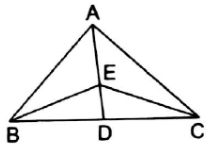The vertex A of ∆ABC is joined to a point D on the side BC. The midpoint of AD is E. Prove that ar(∆BEC) = ![]() ar(∆ABC).
ar(∆ABC). 
Given : A ∆ABC in which AD is a line where D is a point on BC and E is the midpoint of AD
To prove: ar(∆BEC) = ![]() ar(∆ABC)
ar(∆ABC)
Proof: In ∆ABD E is the midpoint of side AD
![]() Area of (∆BDE) = Area of (∆ABE)
Area of (∆BDE) = Area of (∆ABE)
Hence Area of (∆BDE) = ![]() [Area of (∆ABD)] –1
[Area of (∆ABD)] –1
Now, consider ∆ACD in which E is the midpoint of side AD
![]() Area of (∆ECD) = Area of (∆AEC)
Area of (∆ECD) = Area of (∆AEC)
Hence Area of (∆ECD) = ![]() [Area of (∆ACD)] –2
[Area of (∆ACD)] –2
Now, adding –1 and –2, we get
Area of (∆BDE) + Area of (∆ECD) = ![]() [Area of (∆ABD)] +
[Area of (∆ABD)] + ![]() [Area of (∆ACD)]
[Area of (∆ACD)]
![]() area(∆BEC) =
area(∆BEC) = ![]() [area(∆ABD) + area(∆ACD)]
[area(∆ABD) + area(∆ACD)]
![]() Area(∆BEC) =
Area(∆BEC) = ![]() Area(∆ABC)
Area(∆ABC)
Hence proved
18